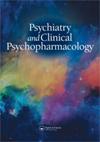11th International Congress on Psychopharmacology & 7th International Symposium on Child and Adolescent Psychopharmacology
IF 0.5
4区 医学
Q4 PHARMACOLOGY & PHARMACY
引用次数: 0
Abstract
Objective: Attention-deficit hyperactivity disorder (ADHD) is the most common neurodevelopmental disorder in school-age children. It is accepted that sensory-motor and attention functions are closely associated and up to two thirds of children with ADHD suffer motor skill problems that adversely affect their social adaptation, peer relations, and academic skills. Atomoxetine (ATX) and methylphenidate (MPH) are preferentially used drugs for treatment. MPH is a central nervous system stimulant, whereas ATX is a non-stimulant selective norepinephrine reuptake inhibitor that is used to treat ADHD. The impact of ATX and MPH on attention and ADHD symptoms is well documented. However, the effects of MPH on motor skills are less studied and no data are currently available on the effects of atomoxetine on motor skills. The aim of this study is to investigate the effects of MPH and ATX on gross and fine motor skills in school-aged children with ADHD. Methods: Participants were 36 right-handed boys with ADHD (aged between 6 and 10 years, mean 7.88 years). The Kiddie Schedule for Affective Disorders and Schizophrenia-Present and Lifetime Version was used to confirm the diagnosis and rule out other comorbid psychiatric disorders. Gross and fine motor skills were assessed with the Bruininks–Oseretsky Test of Motor Proficiency, Second Edition (BOT-2). Twenty-five boys were treated with ATX and 11 with methylphenidate. BOT-2 was applied to both groups before and after 8–12 weeks of treatment. Results: There were no statistically significant differences between the ATX and the MPH groups for all subtests of BOT-2 preand post-medication. When both groups were compared in terms of preand post-treatment gross and fine motor skills, the scores for fine manual control of 12 (48%) children in ATX group increased but did not reach statistical significance. The scores for fine manual control of 5 (45%) children in MPH group increased but did not reach statistical significance. Surprisingly, statistically significant decrease was found in running speed and agility, strength, and body coordination scores in the ATX group, and statistically significant decrease was found in body coordination score in the MPH group. Conclusion: Motor coordination is important in daily life and poor motor skills have a negative impact on a child’s daily living and academic performance. Furthermore, this problem may persist into adulthood with an increase in problems associated with psychosocial adjustment. Our preliminary results revealed that although there was an increase of fine motor control scores after treatment in both groups, statistically significant difference was not found between before and after treatment. Significant decrease in speed and agility and strength scores may be due to reduced impulsivity. While few studies have revealed an improvement on standardized evaluation of attention and motor skills in children taking MPH, more research is needed to gain an understanding of the relationship between motor skills deficits, attention, inhibition, and the effects of ADHD medications.第十一届国际精神药理学大会暨第七届儿童与青少年精神药理学国际研讨会
目的:注意缺陷多动障碍(ADHD)是学龄期儿童最常见的神经发育障碍。人们普遍认为,感觉-运动和注意力功能密切相关,多达三分之二的多动症儿童患有运动技能问题,这对他们的社会适应、同伴关系和学习技能产生了不利影响。阿托莫西汀(ATX)和哌醋甲酯(MPH)是首选的治疗药物。MPH是一种中枢神经系统兴奋剂,而ATX是一种非兴奋剂选择性去甲肾上腺素再摄取抑制剂,用于治疗多动症。ATX和MPH对注意力和ADHD症状的影响是有充分记录的。然而,MPH对运动技能的影响研究较少,目前还没有关于托莫西汀对运动技能影响的数据。本研究的目的是探讨MPH和ATX对学龄ADHD儿童粗大和精细运动技能的影响。方法:参与者为36名患有ADHD的右撇子男孩(年龄6 ~ 10岁,平均7.88岁)。情感障碍和精神分裂症的儿童时间表-现在和终生版本用于确认诊断并排除其他共病精神障碍。采用Bruininks-Oseretsky运动能力测验第二版(BOT-2)评估粗大和精细运动技能。25名男孩接受ATX治疗,11名男孩接受哌甲酯治疗。治疗前后8-12周,两组均应用BOT-2。结果:ATX组和MPH组在给药前和给药后BOT-2的所有亚测试中均无统计学差异。两组治疗前后粗、精细运动技能比较,ATX组12例(48%)患儿精细手控得分有所提高,但无统计学意义。MPH组5例(45%)患儿的精细手控得分升高,但无统计学意义。令人惊讶的是,ATX组在跑步速度、敏捷性、力量和身体协调得分上有统计学意义的下降,而MPH组在身体协调得分上有统计学意义的下降。结论:运动协调在日常生活中起着重要的作用,运动能力低下会对儿童的日常生活和学习成绩产生负面影响。此外,这个问题可能会持续到成年,与心理社会适应相关的问题也会增加。我们的初步结果显示,虽然两组治疗后精细运动控制评分均有所提高,但治疗前后无统计学差异。速度、敏捷性和力量分数的显著下降可能是由于冲动性降低。虽然很少有研究表明服用MPH的儿童在注意力和运动技能的标准化评估方面有所改善,但需要更多的研究来了解运动技能缺陷、注意力、抑制和ADHD药物效果之间的关系。
本文章由计算机程序翻译,如有差异,请以英文原文为准。
求助全文
约1分钟内获得全文
求助全文
来源期刊

Psychiatry and Clinical Psychopharmacology
Medicine-Psychiatry and Mental Health
CiteScore
1.00
自引率
14.30%
发文量
0
期刊介绍:
Psychiatry and Clinical Psychopharmacology aims to reach a national and international audience and will accept submissions from authors worldwide. It gives high priority to original studies of interest to clinicians and scientists in applied and basic neurosciences and related disciplines. Psychiatry and Clinical Psychopharmacology publishes high quality research targeted to specialists, residents and scientists in psychiatry, psychology, neurology, pharmacology, molecular biology, genetics, physiology, neurochemistry, and related sciences.
 求助内容:
求助内容: 应助结果提醒方式:
应助结果提醒方式:


